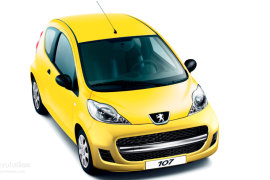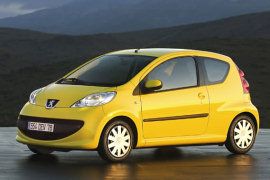PEUGEOT 107 3 Doors Models/Series Timeline, Specifications & Photos
First production year: 2005
Engines: Gasoline, Diesel
Body style: Hatchback
Developed in a joint-venture with Toyota, the Peugeot 107-Citroen C1-Toyota Aygo was a trio of vehicles built in the Czech Republic and sold on the European market in the mini (A) segment.
The carmakers had to refresh their products due to the introduction of the Euro 5 regulation. Peugeot refreshed the 107 as well, starting with 2008. Along with the introduction of the cleaner engines, the Peugeot 107 received an updated design.
The French Lion brand adopted a feline-like shape for the car's headlights, with the main lamp bigger and cutting a slice from the hood. The front bumper was redesigned and featured fake side-scoops on the outer sides. Unlike the non facelifted version, the vertical bar placed in the middle of the grille was painted in silver.
Inside, depending on the trim-level, the 107 featured a tachometer mounted aside from the center speedometer, installed on the steering column assembly moving along when the driver adjusted its position. The center stack's simple layout allowed easy use of the HVAC controls—the 107 featured power windows at the front and a compass-based system for the rear ones.
Under the hood, Toyota provided the 1.0-liter gasoline engine and PSA (Peugeot-Citroen Group) the 1.4-diesel version. Both versions were paired as standard to a 5-speed manual, while a 5-speed automated version was available as an option. The latter consisted of a manual gearbox and a computer-controlled clutch-actuator system.
The French automaker PSA (Peugeot-Citroen) joined forces with Toyota to create a range of supermini vehicles for the European market, resulting in the Peugeot 107, the Citroen C1, and the Toyota Aygo, respectively.
Since both automakers had a huge experience in producing small-sized vehicles, they knew the key to success relied on a low price in that segment. That's why, besides the five-doors version, they also produced a three-door variant, built for those who didn't need the rear seats or needed them only once in a blue moon. Moreover, those vehicles were highly appreciated by delivery companies.
Peugeot used the same brand identity as the one already promoted by the 206, which was on its last stint. That led to a smiling lower grille below the front bumper and no cooling grille above it. Moreover, the headlights were placed very high, and they almost touched the A-pillars due to their length. On the three-door version, the doors were slightly longer than on its five-door sibling.
Inside, there was hardly room for four adults, although the trio created these vehicles, especially for school runs. The cabin featured two seats at the front and a 50/50 split-folding bench in the back, which helped customers to get a decent trunk area, very useful for flat, squared boxes such as those used for pizza. The standard dashboard featured a speedometer and a fuel level gauge. The tachometer was offered as an option. Moreover, to offer the car at an even lower cost, the base version didn't feature an AC or a stereo.
Under the hood, all three siblings shared the same engine, an inline-three, one-liter engine. That was paired with a standard five-speed manual or, as an option, an automated (robotized, single-clutch) gearbox.

